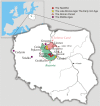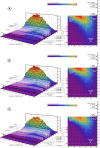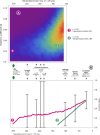Hunting for the LCT-13910*T allele between the Middle Neolithic and the Middle Ages suggests its absence in dairying LBK people entering the Kuyavia region in the 8th millennium BP
- PMID: 25853887
- PMCID: PMC4390234
- DOI: 10.1371/journal.pone.0122384
Hunting for the LCT-13910*T allele between the Middle Neolithic and the Middle Ages suggests its absence in dairying LBK people entering the Kuyavia region in the 8th millennium BP
Abstract
Populations from two medieval sites in Central Poland, Stary Brześć Kujawski-4 (SBK-4) and Gruczno, represented high level of lactase persistence (LP) as followed by the LCT-13910*T allele's presence (0.86 and 0.82, respectively). It was twice as high as in contemporaneous Cedynia (0.4) and Śródka (0.43), both located outside the region, higher than in modern inhabitants of Poland (0.51) and almost as high as in modern Swedish population (0.9). In an attempt to explain the observed differences its frequency changes in time were followed between the Middle Neolithic and the Late Middle Ages in successive dairying populations on a relatively small area (radius ∼60km) containing the two sites. The introduction of the T allele to Kuyavia 7.4 Ka BP by dairying LBK people is not likely, as suggested by the obtained data. It has not been found in any of Neolithic samples dated between 6.3 and 4.5 Ka BP. The identified frequency profile indicates that both the introduction and the beginning of selection could have taken place approx. 4 millennia after first LBK people arrived in the region, shifting the value of LP frequency from 0 to more than 0.8 during less than 130 generations. We hypothesize that the selection process of the T allele was rather rapid, starting just after its introduction into already milking populations and operated via high rates of fertility and mortality on children after weaning through life-threatening conditions, favoring lactose-tolerant individuals. Facing the lack of the T allele in people living on two great European Neolithization routes, the Danubian and Mediterranean ones, and based on its high frequency in northern Iberia, its presence in Scandinavia and estimated occurrence in Central Poland, we propose an alternative Northern Route of its spreading as very likely. None of the successfully identified nuclear alleles turned out to be deltaF508 CFTR.
Conflict of interest statement
Figures





Similar articles
-
Absence of the lactase-persistence-associated allele in early Neolithic Europeans.Proc Natl Acad Sci U S A. 2007 Mar 6;104(10):3736-41. doi: 10.1073/pnas.0607187104. Epub 2007 Feb 28. Proc Natl Acad Sci U S A. 2007. PMID: 17360422 Free PMC article.
-
Low prevalence of lactase persistence in Neolithic South-West Europe.Eur J Hum Genet. 2012 Jul;20(7):778-82. doi: 10.1038/ejhg.2011.254. Epub 2012 Jan 11. Eur J Hum Genet. 2012. PMID: 22234158 Free PMC article.
-
Ancient DNA analysis reveals high frequency of European lactase persistence allele (T-13910) in medieval central europe.PLoS One. 2014 Jan 23;9(1):e86251. doi: 10.1371/journal.pone.0086251. eCollection 2014. PLoS One. 2014. PMID: 24465990 Free PMC article.
-
From 'lactose intolerance' to 'lactose nutrition'.Asia Pac J Clin Nutr. 2015;24 Suppl 1:S1-8. doi: 10.6133/apjcn.2015.24.s1.01. Asia Pac J Clin Nutr. 2015. PMID: 26715078 Review.
-
The onset of lactase persistence in Europe.Hum Hered. 2013;76(3-4):154-61. doi: 10.1159/000360136. Epub 2014 May 21. Hum Hered. 2013. PMID: 24861860 Review.
Cited by
-
Determination of Milk Products in Ceramic Vessels of Corded Ware Culture from a Late Eneolithic Burial.Molecules. 2018 Dec 7;23(12):3247. doi: 10.3390/molecules23123247. Molecules. 2018. PMID: 30544625 Free PMC article.
-
Genetics of Lactose Intolerance: An Updated Review and Online Interactive World Maps of Phenotype and Genotype Frequencies.Nutrients. 2020 Sep 3;12(9):2689. doi: 10.3390/nu12092689. Nutrients. 2020. PMID: 32899182 Free PMC article. Review.
-
Analysis of LCT-13910 genotypes and bone mineral density in ancient skeletal materials.PLoS One. 2018 Apr 30;13(4):e0194966. doi: 10.1371/journal.pone.0194966. eCollection 2018. PLoS One. 2018. PMID: 29708972 Free PMC article.
References
-
- Enattah NS, Sahi T, Savilahti E, Terwilliger JD, Peltonen L, Jarvela L (2002) Identification of a variant associated with adult-type hypolactasia. Nat Genet 30: 233–237. - PubMed
-
- Enattah NS, Jensen TG, Nielsen M, Lewinski R, Kuokkanen M, Rasinpera H, et al. (2008) Independent introduction of two lactase-persistence alleles into human populations reflects different history of adaptation to milk culture. Am J Hum Genet 82: 57–72. 10.1016/j.ajhg.2007.09.012 - DOI - PMC - PubMed
Publication types
MeSH terms
Substances
Associated data
- Actions
- Actions
- Actions
- Actions
- Actions
- Actions
- Actions
- Actions
- Actions
- Actions
- Actions
- Actions
- Actions
- Actions
- Actions
- Actions
- Actions
- Actions
- Actions
- Actions
- Actions
- Actions
- Actions
- Actions
- Actions
- Actions
- Actions
- Actions
- Actions
- Actions
- Actions
- Actions
- Actions
- Actions
- Actions
- Actions
- Actions
- Actions
- Actions
- Actions
- Actions
- Actions
- Actions
- Actions
- Actions
- Actions
- Actions
- Actions
- Actions
- Actions
- Actions
- Actions
- Actions
- Actions
- Actions
- Actions
- Actions
- Actions
- Actions
- Actions
- Actions
- Actions
- Actions
- Actions
- Actions
- Actions
- Actions
- Actions
- Actions
- Actions
- Actions
- Actions
- Actions
- Actions
- Actions
- Actions
- Actions
- Actions
- Actions
- Actions
- Actions
- Actions
- Actions
- Actions
- Actions
- Actions
- Actions
- Actions
- Actions
- Actions
- Actions
- Actions
- Actions
- Actions
- Actions
- Actions
- Actions
- Actions
- Actions
- Actions
- Actions
- Actions
- Actions
- Actions
- Actions
- Actions
- Actions
- Actions
- Actions
- Actions
- Actions
- Actions
- Actions
- Actions
- Actions
- Actions
- Actions
- Actions
- Actions
- Actions
- Actions
- Actions
- Actions
- Actions
- Actions
- Actions
- Actions
- Actions
- Actions
- Actions
- Actions
LinkOut - more resources
Full Text Sources
Other Literature Sources
Medical
Research Materials

